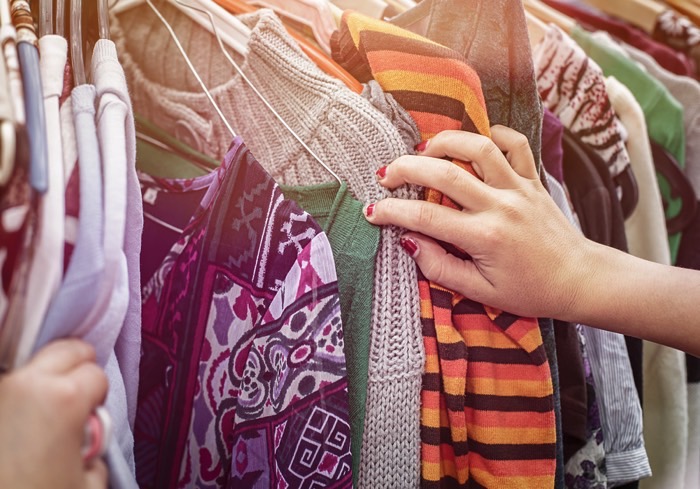ThredUP And The Resale Retail Revolution

Resale retail is a rapidly exploding business — particularly if one happens to be in the business of reselling clothes. According to thredUP’s most recent resale retail report, annually resale retail clocks in as a $40 billion industry, 49 percent of which ($18 billion) alone is apparel sales. That number is projected to climb to $33 billion by 2021.
Attitudes about shopping at thrift and consignment stores have evolved significantly over the last 25 years. While once shopping second hand was mostly the realm of the exceptionally fashion forward, the very broke or the value-conscious grandmothers of the world, these days a full one third of women surveyed said they either already shop second hand or plan to do so in the next year.
“Part of the shift is in how the mobile and digital economy has opened up aspirational brands for customers who previously had to settle for cheaper, fast-fashion alternatives,” thredUP’s Founder and CEO, James Reinhart, told PYMNTS in an emailed conversation. “When the choice is between a Diane Furstenberg bag or dress or the mass market knock off, we let customers access the better brand they would not have otherwise been able to afford new.”
But, Reinhart noted, part of the shift is in the consumers themselves — what they want, how they shop and who is showing up to buy second hand.
Grandma Still Loves Thrift Shopping — (So Does Her Affluent Millennial Granddaughter)
Grandmothers love consignment shopping as much as they ever have — they are still the leading group buying second hand, at 32 percent of the market. But they are closely followed in their admiration for secondhand wares by the youngest generation of consumers: 30 percent of millennial shoppers surf the resale markets. Boomers and Gen Xers somewhat less so.
Their reasoning is admittedly different. Women over 65 are largely shopping for value — they are 3.4 times more likely to name that as their primary reason for buying second hand. Younger buyers, on the other hand, are 2.4 times more likely to name environmental concerns when buying previously owned wares. Plus, 84 percent of millennial consumers noted their preference to spend on “socially conscious brands that reflected their values,” even when shopping second hand.
However, Reinhart noted, while older shoppers showed the strongest stated preference for value, everyone loves a bargain.
“When it comes to bargain shopping, it is fair to note that the general sub-category of women favor buying things for less. Our data indicates that 94 percent of the women we talked to rarely buy full price — and a full 40 percent won’t even so much as enter a store if they don’t see significant discounting signaled.”
One might assume a value-obsessed customer base comes by that preference out of need, but as it turns out, the resale shopper is also getting richer.
High income shoppers (those who earn $125K or more a year) are actually 35 percent more likely to give secondhand retail online a chance than low income shoppers. The most active thredUP shoppers, the data notes, make between $250K and $1M per year (36 percent), with 10 percent bringing in over $1M a year and 31 percent earning between $50K and $250K per year. The vast majority are working professionals (77 percent), living in urban areas (73 percent) who own their own home (71 percent).
But more than a shift in who is shopping second hand — recent data is also indicating a change in how consumers are shopping. It’s not just about buying, says Reinhart, it is also about being entertained.
Social Shopping
“Shopping second hand, as opposed to shopping, say, at comparably priced fast fashion — it is much more an adventure in discovery and much more a chance to really find something that is exciting and sharable.”
It seems fun is a big draw, at least by the numbers, with 76 percent of survey shoppers noting “fun” as one of their top three reasons for shopping second hand.
The drinking may help with that — apparently 63 percent of people believe shopping goes better with wine in hand — something in which we can’t in principle argue. Secondhand shoppers also like the chance to think about these purchases in their own homes — 85 percent noted consignment shopping is better done from the couch with a dog by your side (yes, survey respondents specifically mentioned their dogs).
And it is clearly absorbing for those who do it. The average Facebook user spends about 35 minutes a day checking out the latest in their high school friends’ failing diets — the average thredUP user spends 45 minutes a day looking for the next big thing in pre-owned clothes. Netflix is still winning — with an average of an hour and 33 minutes per day — but regular online apparel is notably only catching nine minutes a day on average.
So is secondhand retail about to displace buying first-hand?
We doubt it.
But it is certainly building up as an interesting price-point competitor for fast fashion. Plus, it can bring generations together — and how much of retail can really say that.